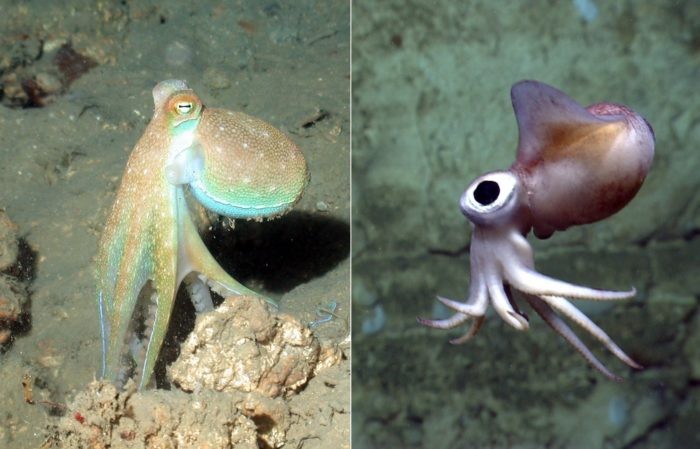It’s a common misconception to mistake a squid for an octopus. These fascinating marine creatures, both belonging to the cephalopod family, share similarities, but possess distinct characteristics. Like cousins in the animal kingdom, octopuses and squids are indeed related—both are part of the group cephalopoda, a class of marine mollusks that also includes nautiluses and cuttlefish. Cephalopods are characterized by their bilateral symmetry, lack of vertebrae, prominent heads, and appendages extending from their bodies. Unlike their shelled relatives, nautiluses and snails, both octopuses and squids have evolved soft bodies, relying on remarkable adaptations such as camouflage, high intelligence, and strong, flexible limbs for protection instead of a hard shell.
With around 300 species of squids and a similar number of octopus species inhabiting our oceans, distinguishing between them becomes essential to truly appreciate their unique adaptations. So, what exactly sets them apart, and crucially, How Many Tentacles Does A Squid Have compared to an octopus? Let’s dive into the fascinating world of cephalopods to explore their differences.
Tentacles vs. Arms: Decoding Cephalopod Limbs
When discussing cephalopods, the terms “arms” and “tentacles” often come up, and it’s vital to understand the difference. Both are muscular hydrostats, meaning they function without bones, relying on muscle and fluid pressure for movement and manipulation. However, tentacles are specifically defined as longer, retractable appendages primarily used for capturing prey, and they feature suckers usually only at their tips. Arms, on the other hand, are generally shorter, non-retractable, and equipped with suckers along their entire length, used for locomotion, grasping, and manipulating objects.
Now, to answer the core question: a squid has ten appendages in total, but not all of them are tentacles. A squid possesses eight arms and two tentacles. These two tentacles are the longer appendages that differentiate squids from octopuses in terms of limb count and function. Octopuses, conversely, have eight arms and no tentacles. This is a primary distinguishing anatomical feature between these two cephalopod cousins. The squid’s tentacles are crucial for hunting, rapidly extending to snatch prey from a distance and retracting to bring food to their mouths.
 Comparison of an octopus and a squid, highlighting their different body shapes and appendages
Comparison of an octopus and a squid, highlighting their different body shapes and appendages
Visual Differences: Spotting a Squid from an Octopus
Beyond the number of tentacles, several visual cues can help distinguish a squid from an octopus. Octopuses are characterized by their rounded, bulbous bodies or mantles and lack prominent fins. Their heads are also rounded, and their eyes feature rectangular pupils. Squids, however, have more elongated, torpedo-shaped bodies. A key visual identifier for squids is the presence of two fins, typically located at the top of their mantle, which they use for stabilization and propulsion through the water. Squid heads are more triangular, and their eyes have circular pupils. Internally, squids possess a unique feature: a rigid, internal structure called a pen, a vestige of a shell that provides support for their mantle.
Habitat and Lifestyle: Where Do They Live and What Do They Eat?
Habitat preferences also differentiate these cephalopods. Squids are generally pelagic creatures, meaning they inhabit the open ocean, ranging from surface waters to the deep sea. They are adept swimmers, often found in schools, navigating the water column in search of food. Octopuses, in contrast, are primarily benthic animals, preferring to live on the seafloor. They seek refuge in dens, rocky crevices, and coral reefs, often camouflaging themselves against the substrate. Both squids and octopuses are found in saltwater environments, from tropical to temperate zones across the globe.
Dietary habits also reflect their habitats. Octopuses, dwelling on the ocean floor, primarily feed on crustaceans such as crabs, shrimp, and lobsters, which they hunt among rocks and sediments. Squids, inhabiting the water column, typically prey on shrimp, small fish, and even other smaller squids they encounter in the open ocean.
Hunting and Feeding: How They Catch Their Meals
The hunting strategies of octopuses and squids differ, reflecting their distinct anatomies. Octopuses, with their eight arms covered in suckers, are masters of manipulation. They use their arms to grab and ensnare prey, often pouncing on crustaceans. To subdue their catch, octopuses can pierce shells or exoskeletons with their beaks and inject paralyzing venom. They then crush the prey’s body within their powerful beaks. Squids, leveraging their two long tentacles, employ a different hunting technique. They use these tentacles to rapidly strike out and capture prey swimming in the open water. Hooks and suckers on the tentacles ensure a firm grip on slippery fish or shrimp, which are then brought to the squid’s mouth to be eaten in chunks.
Defense Mechanisms: Staying Safe in the Ocean
Both squids and octopuses have evolved impressive defense mechanisms to survive in predator-rich marine environments. One of the most iconic defenses is the ability to expel clouds of ink. While both can do this, it is more commonly associated with squids, who use ink clouds as a smokescreen to confuse predators and make a quick escape in the open ocean. Octopuses are renowned for their camouflage abilities. They can dramatically change color and texture to blend seamlessly with their surroundings, hiding from predators or ambushing prey on the seafloor. Octopuses are also incredibly flexible, able to squeeze their soft bodies into remarkably small crevices and spaces to evade danger.
Reproduction and Life Cycle: Creating the Next Generation
Reproductive strategies also differ between octopuses and squids. Male octopuses have a specialized arm called a hectocotylus, which they use to transfer sperm to the female. Female octopuses are devoted mothers, laying clusters of eggs, often resembling strings of lights, in their dens. The female octopus diligently guards her eggs until they hatch, a period that can range from a month to over a year, depending on the species. Squids, in contrast, engage in mass mating events, often in large groups. They attach their egg masses to fixed structures like rocks or coral. Squid parents exhibit no parental care; once the eggs are laid, they are left to hatch and develop independently.
Lifespans also vary. Octopuses are generally shorter-lived, with most species living for only one to three years. Squids tend to have slightly longer lifespans, ranging from nine months to five years, depending on the species. In both groups, males typically die shortly after mating.
Social Behavior: Lone Rangers or Schooling Squads?
Finally, their social structures differ significantly. Octopuses are predominantly solitary creatures, leading independent lives except during mating periods. Squids, however, can be either solitary or social, with many species living in schools, sometimes of considerable size. This schooling behavior is likely a defense mechanism against predators and may also facilitate mating and foraging.
In conclusion, while both squids and octopuses are captivating cephalopods sharing a common ancestry, they have evolved distinct features and lifestyles. Understanding their differences, especially the crucial fact that a squid has two tentacles in addition to its eight arms, allows for a deeper appreciation of the biodiversity and adaptations within our oceans. From their hunting techniques to their defense strategies and social behaviors, squids and octopuses each play unique and vital roles in marine ecosystems.
